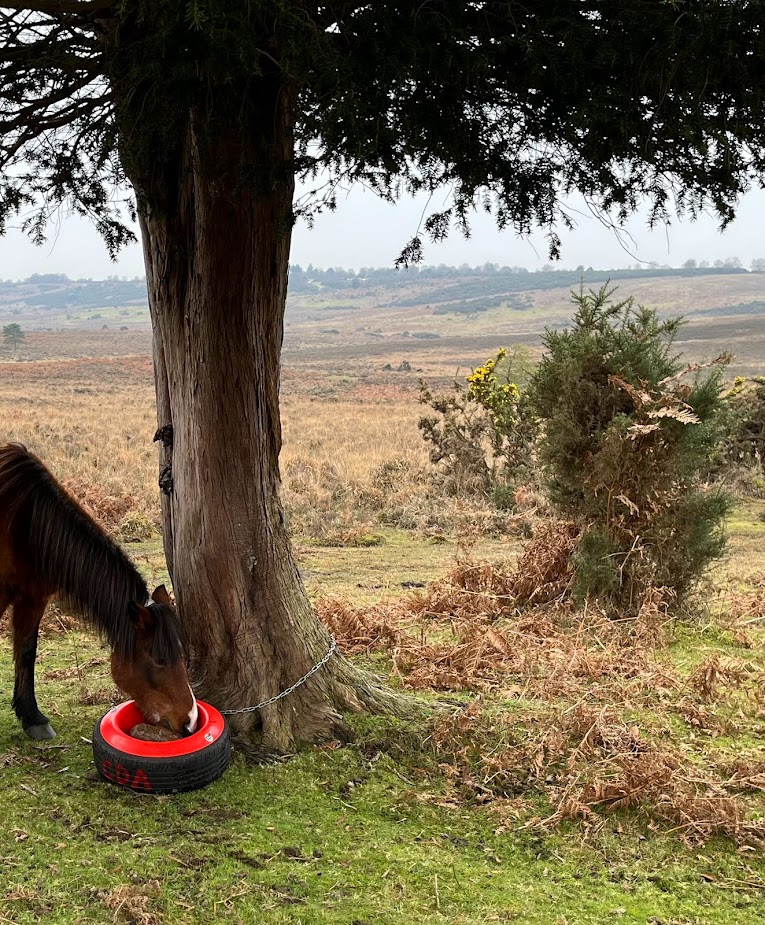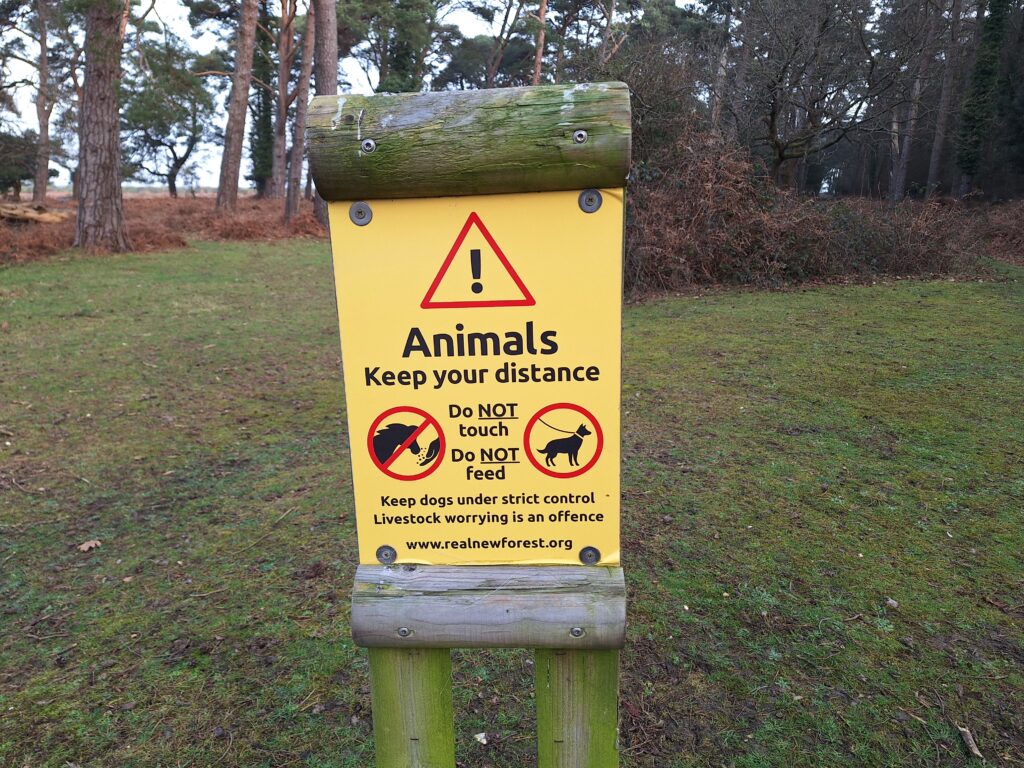New Forest commoners and their livestock have benefitted from several generous grants given to the CDA by the New Forest Trust.
The Trust, which funds projects aimed at helping sustain the New Forest for future generations, has provided a £5,000 grant to go towards the vaccination of cattle against the viral disease BVD (Bovine Viral Diarrhoea).
The vaccinations have taken place over the past few months and will not only help prevent the transmission of the disease in the Forest but also help stop abortions from taking place.
New Forest CDA chair Andrew Parry-Norton said: ‘I would like to say a massive thank you to the New Forest Trust for funding this project. We could not have carried this out without their backing and support.
‘New Forest commoners are not immune to the rising costs of living so I was delighted the CDA could help them out financially with these vaccinations.
‘The program is a really important initiative and one which we hope to replicate in the coming years to boost the overall health of cattle in the Forest.’
The Trust has also funded the salt lick project, which is an ongoing scheme overseen by commoners Tony Vanderhoek and Bill Howells.
The project sees bowls of Himalayan salt put out in various places around the New Forest to encourage ponies and other animals away from the road, and stop them licking the grit spread on roads during icy conditions.
It is aimed particularly around the times when the clocks change and drivers are getting used to different conditions on their morning and afternoon commutes, and also during the winter months when it is dark for longer periods.
Salt licks are among various initiatives, including signage and fencing, aimed at reducing the number of accidents between vehicles and livestock.
Chair of the New Forest Trust William Ziegler said: ‘We are delighted to help New Forest commoners with these two grants. They contribute a huge amount to the landscape and we are happy to support them in any way possible.’
For more information about how to apply for a grant from the New Forest Trust, head to the page here
This report, by New Forest CDA member Sam Dovey, first appeared in the CDA’s annual report for 2024/25.
The New Forest CDA holds an insurance policy with the NFU Mutual covering legal liability (Public Liability) for its activities. Our level of cover, or indemnity limit per claim, is currently set at £10million.
This covers the CDA’s general (and usual) activities such as holding and organising meetings, fund raising events, our mentoring scheme, stock road signs and of course our annual stand at the New Forest Show.
The association also holds Employers Liability for any stewards or helpers assisting directly in connection with association activities.
As an additional membership benefit, the policy is extended to cover legal liability in respect of damage to third party persons or property for all fully paid up ‘full’ members, in respect of their lawfully depastured stock turned out within the fenced and gridded perambulation of the Forest and adjacent commons for the sole function of ‘grazing livestock on the New Forest’.
This is provided for individual members who do not have their own, more specific insurance in place covering their stock, farming and commoning activities which covers the same risk and activities. Where a member has their own, more specific policy in place, this would take prominence in the event of a claim and the association’s policy would not need to be called upon to respond.
The association’s ‘safety net’ policy is, therefore, a real benefit particularly for members who only have a small number of lawfully depastured stock, and for whom arranging an individual policy could be expensive given the very small margins commoners receive.
It must be remembered however, that it should be regarded as a cover of last resort, and the committee would expect most practicing commoners to be arranging their own, more specific cover.
It is also important to be aware that whilst the association’s insurance cover includes legal liability arising from lawfully ‘depastured’ stock whilst grazing on the crown lands and adjacent commons, it will not cover any liability for stock kept in fenced land owned, rented, occupied or used by members; or from any other common land away from the gridded perambulation of the forest or other associated activities other than ‘grazing livestock on the New Forest’.
In this ever-increasing world of litigation, it is your committee’s strong recommendation that members ensure they have cover in place for such situations that may arise off the open Forest, and therefore out of the remit of the association’s policy cover as well as while stock remain on the Forest.
It should be remembered that owning stock that are depastured on the Forest can also mean stock may need to managed away from the Crown lands as well – sometimes at very short notice.
This is particularly relevant for cattle keepers, as cattle will be off the forest for certain periods (eg annual TB testing and marking) and we believe that no cover is in place for scenarios such as this under the association cover.
The same principle would also apply in respect of stallions where cover for these would only apply for the period any stallion was lawfully depastured and running on the open Forest. There would be no cover under the association’s policy while they are off the Forest, or in the stallion grazing scheme.
Whether members rely on the association’s blanket safety net cover, or have their own policy in place, it should be remembered that all insurance policies have terms, conditions and limitations that need to be followed to ensure that the cover is in place correctly.
Ultimately, as a stock owner and keeper, members are responsible for the actions of their stock notwithstanding insurance cover that may be in place or any rights to turn stock on the Crown lands and adjacent commons.
If members have any queries concerning the association’s insurance cover, please do not hesitate to contact either myself or one of your committee members, we are always happy to talk.
Any formal insurance queries or requests that could involve a potential claim should be made, without delay, in writing via the association’s secretary.
Forest Stock: RTA recovery service
As reported previously, after many years of providing an uninsured loss recovery service for stock killed or injured on Forest roads, the association was unable to find a way of providing this service for members going forward.
The committee continue to keep this on the agenda, and if circumstances change and a solution can be found, then we will inform members.
On a more positive note, our insurers, NFU Mutual, have informed us that they have developed an option with ARAG Plc (formally DAS Legal Expenses insurance) to assist with recovery of these losses for their policyholders.
We understand that this service would be via an annual insurance policy that individuals may need to add to their existing NFU Mutual insurance policies and may incur an annual fee to maintain the cover.
For more information, please contact NFU Mutual directly at its offices in New Park, Brockenhurst.
Sam Dovey, New Forest CDA committee member
The chair of the New Forest CDA has reminded members of the public to be extra vigilant in and around the Forest.
It comes amid the 21 stallions which are now out on the Forest for a six-week period, to breed with the free-roaming mares.
Their often unpredictable behaviour during this time means those out enjoying the New Forest should keep their distance, while dogs should be kept away and on leads.
‘Stallions are now out on the Forest and we’ve got some lovely looking animals out there,’ said chair Andrew Parry-Norton. ‘But please, members of the public, please do stay clear.
‘And if you’re out riding a pony, a stallion will come across to investigate and check you out to find out if you’re a threat or whether you can be included in the herd. So if you do ride, go right around the stallions and keep well away.
‘Also, the ponies are very skittish – they’re running all over the place at the moment and crossing roads very, very quickly so as drivers, please be aware of that.’
The stallions are are let out each year to help maintain the New Forest pony bloodlines and control the number of foals born each year.
They are out on the Forest for several more weeks and can start coming in during the week beginning Monday, 16 June.
Commoners are invited to a summer round-up at the start of next month.
The event, which is being put on by the Young Commoners committee, is open to all New Forest commoners and is taking place at Nuthatch Cottage, Storms Farm in Cadnam on Saturday, 5 July.
There will be a barbecue, live band and games, as well as a bar. Tickets cost £5 per person while under 15s are free.
All profits from the round-up go towards the Young Commoners’ Injured Stallion fund.
More information on the Facebook event page here and tickets can be purchased here
New Forest CDA chair Andrew Parry-Norton has raised his concerns about the introduction of food waste bins by New Forest District Council.
In a presentment at Verderers Court on Wednesday, May 21, he spoke about the risk to livestock. He said commoners’ animals could access the bins and consume the food waste – potentially affecting their health.
Andrew urged Verderers to speak to the council – who are introducing a phased roll-out of the bins – about changing the advice to the public from leaving the bins outside enclosed areas to leaving them within, to help protect animals.
‘Not only could the bins be a problem for pigs, but also donkeys and ponies who will quickly realise this could become a potential food source,’ he told the court.
‘We, the CDA, ask the Verderers to persuade New Forest District Council to retract their advice and request that these bins are kept on the residents’ premises where stock do not have access to it.’
You can read Andrew’s presentment in full below.
CDA Presentment at Verderers Court – May 2025
The introduction of new food waste bins for New Forest residents and a recent visit by DEFRA officials were among the topics of discussion in Andrew Parry-Norton’s monthly video update.
In his latest chat to New Forest CDA members, he also talks about preparing to go into a Landscape Recovery scheme and issues a reminder to members of the public about stallions.
Watch his full update below or on our Facebook page
Do you know someone who makes an exceptional contribution to New Forest commoning? Then now is the time to get them recognised as part of the New Forest National Park Awards.
The annual awards, which is in its 12th year and run by the New Forest National Park Authority and the Country Land and Business Association (CLA), recognise outstanding contributions to the environment, rural economy and local communities in and around the National Park.
This year, as the New Forest National Park marks its 20th anniversary, a new award – Commoning Champion – has been introduced to recognise individuals playing a vital role in sustaining the unique practice which helps maintain the Forest’s landscape and biodiversity.
To be nominated for the Commoning Champion category, the following criteria must be met:
- Demonstrates sustainability and regenerative farming in the context of the New Forest as well as responsibility for, respect and care of the New Forest landscape
- Demonstrates support for the commoning community – for example as member of the CDA and/or the New Forest Marque, attending the Verderers Court, supporting/attending drifts
- Demonstrates a commitment to public education
- Has a strong commitment to high welfare standards and practices, overall condition of cattle and ponies
- Has a management plan for the holding and improvement of livestock
- Contributes to the management of the interaction between visitors and his / her stock
- Demonstrates an understanding of the history of commoning and the Forest and the role of the different organisations in managing the New Forest landscape
Individuals can nominate themselves or be nominated by others. All nominees must live, work or operate within the New Forest Awards area.
The other categories are Sustainability Champion, Young Farmer (aged 35 and under), Best Supporter of Local Produce, Young Environmental Champion (aged 25 and under) and Farming and Nature Champion.
Winners will be announced at a special awards ceremony and drinks reception at the New Forest and Hampshire County Show on Wednesday, 30 July. The event is supported by Moore Barlow and the New Forest Agricultural Show Society.
Nominations close on Sunday, 8 June. Full criteria and nomination forms are available at www.newforestnpa.gov.uk/newforestawards
The New Forest CDA committee has been confirmed for the year 2025/26.
Andrew Parry-Norton has been re-elected as the group’s chair, with Keith Mansbridge replacing Robert Stride as vice chair.
The decisions were made at the CDA’s monthly committee meeting on Tuesday, May 6.
Andrew Parry-Norton said: ‘I am delighted to be re-elected as CDA chair. I will continue to fight for commoners in all areas and ensure our voices are heard so we have a bright future to look forward to.
‘And I would like to place on record my thanks for all the work Robert has done as vice chair. He has gone above and beyond to help commoners over the years and his support to me has been invaluable.
‘I am now looking forward to pushing on for 2025/26 and seeing the CDA go from strength to strength.’
The full committee for the year ahead can be viewed below.
2025/26 Committee
Mike Eccles (President), Andrew Parry-Norton (Chair), Keith Mansbridge (Vice Chair), Richard Deakin (Treasurer), Hilary Harper (Secretary)
Elected members: Mark Adams, Sami Blastock, Adam Coutts, Ben Dolbear, Erika Dovey, Sam Dovey, Fiona Gover, Kay Harrison, Tom Hordle, Bill Howells, Brian Ingram, Ben Mansbridge, Martin Pate (Hon Solicitor), John Pooley, Daisy Slocombe, Debbie Stokes, Robert Stride, Philip Stride, Tony Vanderhoek, James Young, Alex Crook (farm vet), Laura Trigg (equine vet)
Co-opted members: Jonathan Gerrelli, Robyn Loveless, Julian Pothecary, Anita Smith, Alice Rowe, James Young
This is a report on salt licks, signs and replacement fences in the New Forest, organised by CDA committee member Tony Vanderhoek. The report was first published in the CDA annual report for 2024/25.
Salt licks
The CDA salt lick project is now in its fourth season led by Bill Howells and myself.
After a trial over three winters up along the B3078 Cadnam to Fordingbridge with 17 salt licks sited, it was decided that we should now extend it to the B3054 Dibden to Beaulieu/Beaulieu to Lymington road.
The accident figures seemed to show a reduction in the B3078, with the highest number of accidents now along the B3054. We were a bit late in getting the salt licks out this year (24/25) as we had to renew the Forestry England licence and a risk assessment to include the B3054. This also involved a ‘recce’ along that stretch of road to figure out their best sites and how many we would need for FE to agree on before issuing the licence.
Thirteen more salt bins were needed, so Bill and I set to work sourcing old tyres that were the right size and buying the bowls, chain, shackles and bolts to finally putting them together them in Bill’s workshop. Once made, we put them out as soon as we could with the salt blocks. A total of 30 bins are now sited.

The salt lick scheme is one initiative trying to reduce the number of animal accidents
This attracted media attention and BBC South Today paid us a visit. This was aired on TV and on radio/social media at the end of January with valuable contributions from Gilly Jones and Hampshire Police highlighting animal awareness whilst driving through the Forest. All helpful stuff.
The good news is that 2024 had the lowest animal road deaths recorded. Let’s hope we can reduce the animal accidents even more with the combination of all the initiatives that we have ongoing in the Forest. We would like to add that The New Forest Trust are now kindly funding this project.
Signs
The CDA and has for several years organised the production of signs sited mainly at the Crown lands Forest car parks to try to prevent visitors from feeding, petting and generally to keep away from our livestock with also messaging to keep dogs under control. Although they won’t totally prevent this interference, it does certainly help.
Quite a lot of effort has been made by all involved to originally initiate and fund this, but it is now generally accepted that this is important and should continue to help protect commoners and visitors alike.
The first livestock signs produced about five or so years ago certainly created a lot of attention and since then have been replaced with more permanent yellow ‘no feeding’ signs on posts mainly at the Forest car parks and camp sites. At the same time as both these sign formats were deployed, 32 large yellow roadside (‘A frame’) signs were used especially in times of peak visitor pressure that were funded by the FE, Verderers and CDA.
Liked by Rangers, this made their job easier in educating the public when caught interacting with the livestock. Forestry England were deploying these but have now decided that they will only deal with the smaller yellow ‘no feeding’ signs on posts.

Keep your distance from animals sign
The problem with the large signs is that they have a habit of falling over, being trampled upon or being stolen. The surviving 20 or so are still used but now generally at pubs, etc. and off the Crown lands. The yellow ‘no feeding’ signs at the car parks are generally holding up okay and I was pleased to see that the Rangers look after them by cleaning them on their visits.
There are no plans at the moment to change or add what are out there now, but at some point we will have to decide on where we go with the signs. With incidents involving livestock, signs are all important.
The future difficulty is how much signage and where without ruining the character and look of the Forest.
Other signs that are being used are ‘slogan signs’. These were originally produced by Hampshire County Council to be fixed around different locations on their signposts and ‘rotated’ around to a seasonal timetable so that drivers would still be made aware of them without the message going stale.
These have now been used for about two years now and does require a lot of effort to keep moving them around. The CDA along with the great help of the Young Commoners are keeping this going and hopefully making an impact.
Fencing
In late 2020, I submitted a presentment to try to resolve the very poor fencing at Cadnam along the A337, as we were especially worried about our animals breaking through and wandering on to that busy road.
This led to further discussions about the general poor fencing throughout the Forest ‘A’ roads and a further presentment was submitted shortly after (during lockdown) on behalf of the CDA to completely replace the poor fencing along all the Hampshire County Council-controlled ‘A’ roads throughout the Forest with higher quality fencing.
A bit of persistence paid off and eventually HCC agreed to replace all this fencing with wooden post and rail/stock netting. Understandably, they didn’t have the funds to do it all at once but over a period of time.
Four years later, I’m pleased to see that large stretches have been replaced. The fencing is far more robust and stock proof and can better cope with fallen branches landing on it. Any breakages tend to be very localised to one top rail rather than pulling down a whole stretch of weak post and wire fencing.
Another benefit about this fencing is that it is highly visible from the road (and in my opinion more pleasing to the eye) and any damage can be quickly and easily seen and reported in comparison to the post and wire.
The only problem we will face in the future that I can see is that the wooden posts nowadays have poor quality preservation and can rot off at the base much faster than in the past (especially in wetter areas). It’ll be interesting to see how long these last before needing replacing.
The fact that the fencing is being replaced over a time means that at least it won’t all need doing at once! It’s good to see that HCC is taking this seriously and doing what it said it would do.
Future funding is uncertain though as councils are surviving on less and less money. We will have to wait and see what happens, and hope for the best.
Tony Vanderhoek, CDA Committee member
Other articles from CDA annual report
- Birch felling, track repairs and bridge battle among key issues on open Forest
- The ongoing challenge of encroachments for the New Forest CDA
- Campaigning continues to help reduce number of New Forest animal accidents
- New Forest Young Commoners: ‘A pivotal time to stand up, be counted and take action’
Andrew Parry-Norton outlined a number of key issues facing commoners in his monthly video update.
He talks about a report from New Forest National Park Authority member Brice Stratford looking into commoners getting recognition as a ‘national minority,’ as well as an upcoming visit by DEFRA officials and a meeting with Camping in the New Forest among other things.
Watch his video in full below or on the New Forest CDA’s Facebook page here
In case you missed any of Andrew’s videos from recent months, check them out below.

Members Login
 Latest Tweets
Latest Tweets
Follow us
@realnewforest 4h
Icilibus sam quas aut eriatem nume corepta auta conet officaborem quodi corepta auta conet officaborem quodi apernat ectlpa dolorpiaecus.
@realnewforest 4h
Icilibus sam quas aut eriatem nume corepta auta conet officaborem quodi corepta auta conet officaborem quodi apernat ectlpa dolorpiaecus.
@realnewforest 4h
Icilibus sam quas aut eriatem nume corepta auta conet officaborem quodi corepta auta conet officaborem quodi apernat ectlpa dolorpiaecus.
With thanks for support from



